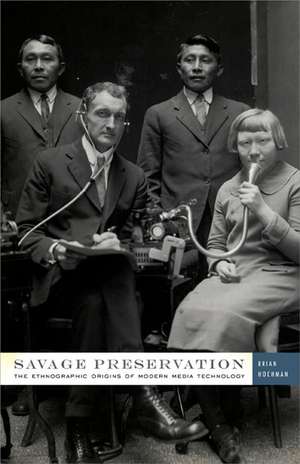Savage Preservation: The Ethnographic Origins of Modern Media Technology
Autor Brian Hochmanen Limba Engleză Paperback – 15 noi 2014
During the late nineteenth and early twentieth centuries, writers and anthropologists believed that the world’s primitive races were on the brink of extinction. They also believed that films, photographs, and phonographic recordings—modern media in their technological infancy—could capture lasting relics of primitive life before it vanished into obscurity. For many Americans, the promise of media and the problem of race were inextricably linked. While professional ethnologists tried out early recording machines to preserve the sounds of authentic indigenous cultures, photographers and filmmakers hauled newfangled equipment into remote corners of the globe to document rituals and scenes that seemed destined to vanish forever.
In Savage Preservation, Brian Hochman shows how widespread interest in recording vanishing races and disappearing cultures influenced audiovisual innovation, experimentation, and use in the United States. Drawing extensively on seldom-seen archival sources—from phonetic alphabets and sign language drawings to wax cylinder recordings and early color photographs—Hochman uncovers the parallel histories of ethnography and technology in the turn-of-the-century period. While conventional wisdom suggests that media technologies work mostly to produce ideas about race, Savage Preservation reveals that the reverse has also been true. During this period, popular conceptions of race constructed the authority of new media technologies as reliable archives of the real. Brimming with nuanced critical insights and unexpected historical connections, Savage Preservation offers a new model for thinking about race and media in the American context—and a fresh take on a period of accelerated technological change that closely resembles our own.
In Savage Preservation, Brian Hochman shows how widespread interest in recording vanishing races and disappearing cultures influenced audiovisual innovation, experimentation, and use in the United States. Drawing extensively on seldom-seen archival sources—from phonetic alphabets and sign language drawings to wax cylinder recordings and early color photographs—Hochman uncovers the parallel histories of ethnography and technology in the turn-of-the-century period. While conventional wisdom suggests that media technologies work mostly to produce ideas about race, Savage Preservation reveals that the reverse has also been true. During this period, popular conceptions of race constructed the authority of new media technologies as reliable archives of the real. Brimming with nuanced critical insights and unexpected historical connections, Savage Preservation offers a new model for thinking about race and media in the American context—and a fresh take on a period of accelerated technological change that closely resembles our own.
Preț: 140.95 lei
Preț vechi: 170.61 lei
-17% Nou
Puncte Express: 211
Preț estimativ în valută:
26.97€ • 28.84$ • 22.49£
26.97€ • 28.84$ • 22.49£
Carte indisponibilă temporar
Doresc să fiu notificat când acest titlu va fi disponibil:
Se trimite...
Preluare comenzi: 021 569.72.76
Specificații
ISBN-13: 9780816681389
ISBN-10: 0816681384
Pagini: 312
Ilustrații: 30
Dimensiuni: 140 x 216 x 23 mm
Greutate: 0.37 kg
Ediția:1
Editura: University of Minnesota Press
Colecția Univ Of Minnesota Press
ISBN-10: 0816681384
Pagini: 312
Ilustrații: 30
Dimensiuni: 140 x 216 x 23 mm
Greutate: 0.37 kg
Ediția:1
Editura: University of Minnesota Press
Colecția Univ Of Minnesota Press
Notă biografică
Brian Hochman is assistant professor of English at Georgetown University.
Cuprins
Contents
Introduction: The Passamaquoddy Experiment
1. Media Evolution: Indians, Alphabets, and the Technological Measures of Man
2. Representing Plains Indian Sign Language
3. Originals and Aboriginals: Race and Writing in the Age of the Phonograph
4. Race, Empire, and the Skin of the Ethnographic Image
5. Local Colors: The Work of the Ethnographic Autochrome
Postscript: Fictions of Permanence
Acknowledgments
Notes
Bibliography
Index
Introduction: The Passamaquoddy Experiment
1. Media Evolution: Indians, Alphabets, and the Technological Measures of Man
2. Representing Plains Indian Sign Language
3. Originals and Aboriginals: Race and Writing in the Age of the Phonograph
4. Race, Empire, and the Skin of the Ethnographic Image
5. Local Colors: The Work of the Ethnographic Autochrome
Postscript: Fictions of Permanence
Acknowledgments
Notes
Bibliography
Index
Recenzii
"Savage Preservation is an eye-opening account of the mutually entangled origins of ethnography and the meanings of modern media: recorded sound, color photography, documentary film. Not only does Brian Hochman enrich his readers’ sense of culture as a concept available to historical change, he demonstrates convincingly that North American media studies remains haunted at its core by the racial ‘science’ of earlier generations." —Lisa Gitelman, New York University
"The book’s intersection of technological development and evolutionist cultural theory make a valuable contribution to media history."—Afterimage
"Refreshing and original."—CHOICE
"Hochman crafts a compelling account of the unexpected ways in which race and new media technologies intersected during this era."—MELUS
"Hochman’s book is a clearly argued, broadly researched work with cogent case studies which should help to broaden our understanding of turn-of-the-century media and technology."—History of Anthropology Newsletter
"Refreshing and original."—CHOICE
"Hochman crafts a compelling account of the unexpected ways in which race and new media technologies intersected during this era."—MELUS
"Hochman’s book is a clearly argued, broadly researched work with cogent case studies which should help to broaden our understanding of turn-of-the-century media and technology."—History of Anthropology Newsletter
